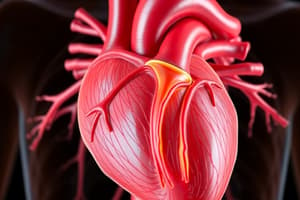Podcast
Questions and Answers
What other calcium sources play a role in excitation-contraction coupling?
What other calcium sources play a role in excitation-contraction coupling?
- Sodium ions
- Mitochondria (correct)
- Chloride ions
- Potassium ions
What is the role of Ca++ ions in the regulation of cardiac muscle fiber contraction and relaxation?
What is the role of Ca++ ions in the regulation of cardiac muscle fiber contraction and relaxation?
- Preventing the initiation of contraction
- Initiating the action potential
- Slowing down the relaxation process
- Enhancing the strength of contraction (correct)
How does extracellular Ca++ ions impact the contraction strength of the heart?
How does extracellular Ca++ ions impact the contraction strength of the heart?
- Decreases the contraction strength
- Halts the contraction process
- Increases the contraction strength (correct)
- Has no effect on contraction strength
How does intracellular calcium concentration modulate the strength of cardiac muscle contraction?
How does intracellular calcium concentration modulate the strength of cardiac muscle contraction?
What is the function of the actin-binding site in myosin?
What is the function of the actin-binding site in myosin?
During muscle contraction, what role does troponin play?
During muscle contraction, what role does troponin play?
What covers the actin active site during the resting state of a muscle?
What covers the actin active site during the resting state of a muscle?
Which component of troponin has a strong affinity for calcium ions?
Which component of troponin has a strong affinity for calcium ions?
During which phase in the cardiac muscle contraction are the L-type Ca++ channels responsible for the depolarization?
During which phase in the cardiac muscle contraction are the L-type Ca++ channels responsible for the depolarization?
In which portion of the left ventricle does blood flow only occur during diastole?
In which portion of the left ventricle does blood flow only occur during diastole?
What is the main source of Ca for cardiac contraction?
What is the main source of Ca for cardiac contraction?
What characterizes the relative refractory period in cardiac muscle?
What characterizes the relative refractory period in cardiac muscle?
Which muscle type depends mainly on ECF Ca for contraction?
Which muscle type depends mainly on ECF Ca for contraction?
How does the relaxation process occur in cardiac muscle?
How does the relaxation process occur in cardiac muscle?
What is the role of the transverse tubule (TT) in cardiac muscle contraction?
What is the role of the transverse tubule (TT) in cardiac muscle contraction?
What is the advantage of the long plateau phase in cardiac muscle contraction?
What is the advantage of the long plateau phase in cardiac muscle contraction?
Flashcards are hidden until you start studying
Study Notes
Calcium Sources in Excitation-Contraction Coupling
- Besides the sarcoplasmic reticulum, extracellular Ca++ ions and Ca++ release from the mitochondria also play a role in excitation-contraction coupling.
Regulation of Cardiac Muscle Fiber Contraction and Relaxation
- Ca++ ions regulate cardiac muscle fiber contraction by binding to troponin, causing a conformational change that exposes the actin-binding site, allowing myosin to interact with actin and produce contraction.
- Ca++ ions also regulate cardiac muscle fiber relaxation by reducing Ca++ ion concentration, allowing troponin to return to its original conformation, blocking the actin-binding site and causing relaxation.
Role of Extracellular Ca++ Ions
- Extracellular Ca++ ions impact the contraction strength of the heart by increasing the amount of Ca++ available for contraction.
Intracellular Calcium Concentration
- Intracellular calcium concentration modulates the strength of cardiac muscle contraction by increasing or decreasing the amount of Ca++ available for contraction.
Actin-Binding Site and Myosin
- The actin-binding site in myosin is involved in muscle contraction by allowing myosin to interact with actin and produce contraction.
Troponin's Role in Muscle Contraction
- During muscle contraction, troponin plays a role by undergoing a conformational change upon Ca++ binding, exposing the actin-binding site and allowing myosin to interact with actin.
Resting State of a Muscle
- The actin active site is covered by tropomyosin during the resting state of a muscle.
Troponin and Calcium Ions
- Troponin-C has a strong affinity for calcium ions, allowing it to detect changes in intracellular calcium concentration.
L-Type Ca++ Channels
- L-type Ca++ channels are responsible for the depolarization of the cardiac muscle fiber during the plateau phase.
Blood Flow in the Left Ventricle
- Blood flow only occurs during diastole in the apex of the left ventricle.
Main Source of Ca for Cardiac Contraction
- The main source of Ca for cardiac contraction is the extracellular fluid (ECF Ca).
Relative Refractory Period
- The relative refractory period in cardiac muscle is characterized by the inability of the muscle to contract again due to the refractory period of the L-type Ca++ channels.
Muscle Type and ECF Ca
- Smooth muscle depends mainly on ECF Ca for contraction.
Relaxation Process in Cardiac Muscle
- The relaxation process in cardiac muscle occurs when Ca++ ion concentration decreases, allowing troponin to return to its original conformation, blocking the actin-binding site and causing relaxation.
Transverse Tubule (TT) in Cardiac Muscle Contraction
- The transverse tubule (TT) plays a role in cardiac muscle contraction by allowing rapid depolarization of the muscle fiber, leading to rapid contraction.
Advantage of the Long Plateau Phase
- The advantage of the long plateau phase in cardiac muscle contraction is that it allows for longer contraction times, resulting in more forceful contractions.
Studying That Suits You
Use AI to generate personalized quizzes and flashcards to suit your learning preferences.




